The art of matching fermented food with beer
By James EvisonAt a special event held at Brat x Climpson’s Arch, the Brewers Association highlighted the significant potential to match fermented food with craft beer.
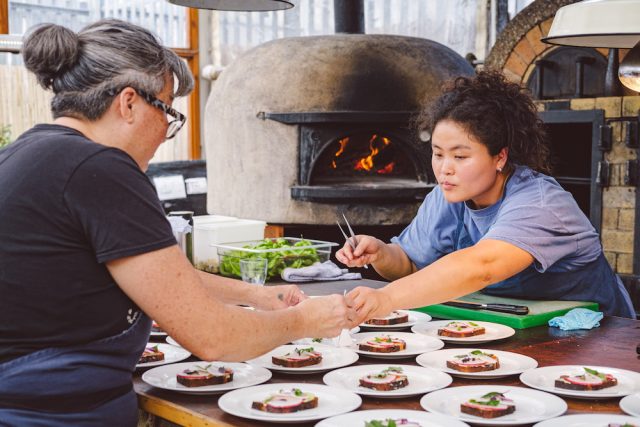
Fermented food and beer made from fermentation? An obvious match, but also a spectacularly tasty one. This event from the Brewers Association, a not-for-profit trade association for small and independent American craft brewers, aimed to explore the pairing potential between fermented foods and American craft beer. And it certainly provided proof of concept.
The experience bought together two chefs from Michelin-starred restaurants, including Song So Kim from the Super 8 restaurants in London, and Mara King from Id Est Hospitality in Boulder, Colorado. Both of the chefs are renowed experts on fermentation, as the menu undoubtedly revealed, and their deep knowledge was consistently shown as they detailed elements of the dishes throughout the occasion.
They were joined by Adam Dulye, who is the executive chef of the Brewers Association, and himself a world leader in beer and food pairing. Commencing proceedings, Duyle said the menu was a “meeting of the restaurant groups”, and part of their “incredibly extensive fermentation programmes”.
Resurgence
Mara added that there had been a “resurgence of fermentation within restaurant culture” recently. She said that the way to make “novel ingredients” was to “make them yourself”. Speaking about her work in Colorado, she said a short growing season, from May to October, was supplemented by fermentation to allow restaurants to use produce into the winter, such as cherries.
In addition, she said it reduces waste, by taking something that is “bound for the bin and use as an ingredient”. Using bread as an example, she said that you can use koji, the fungus used in sake, to break down bread into an umami sauce.
Adding her view, Song So Kim said that fermentation was a “really great way to engage with farmers” and “using our ancestral knowledge” to create a bridge from the field to the table.
Menu
The menu comprise courses paired with a different beer style, each exploring fermentation in different ways.
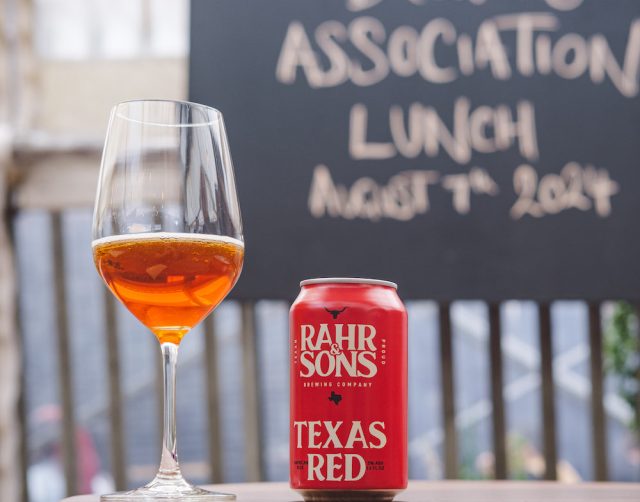
At arrival, guests were given a Texas Red from Rahr & Sons Brewing Co. This beer had a medium body and light to middling mouthfeel, with notes of caramel and sweet toasted malt with a mellow finish.
Fritz Rahr, president and CEO, told db that the brewery specialised in lighter styles, and the 5% ABV beer aimed to be sessionable with a malt-forward profile with a little bit of hops. Lightly biscuity, it made for a superb aperitif.
Amuse bouche
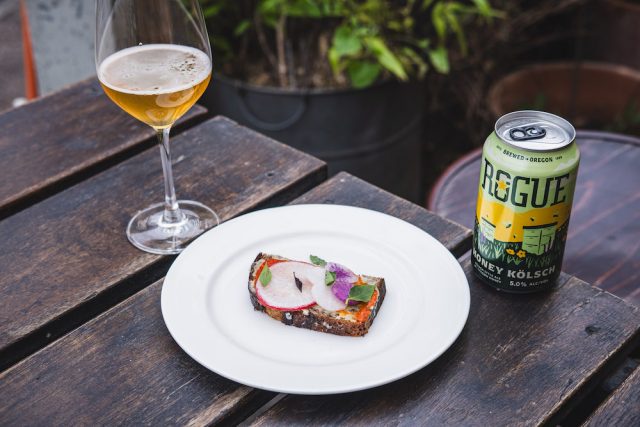
The first course of the meal, an amuse bouche, saw a Rogue Brewery Honey Kolsch brewed with low levels of wildflower honey, and producing subtle floral notes.
It was matched with bread and butter, radish and fresno sriracha.The sriracha was made over an approximate 7-day ferment period and incorporated the key elements of this fermented sauce; spicy (fresno chili), sweet (sugar), salty (salt and radish), and tangy (fermentation).
Rogue Ales’s Reid Bearisto, the brewery’s international manager, said the beer “cleans out” the palate with its classic top-fermented Kolsch style, making it an ideal partner for the bread dish.
Beef
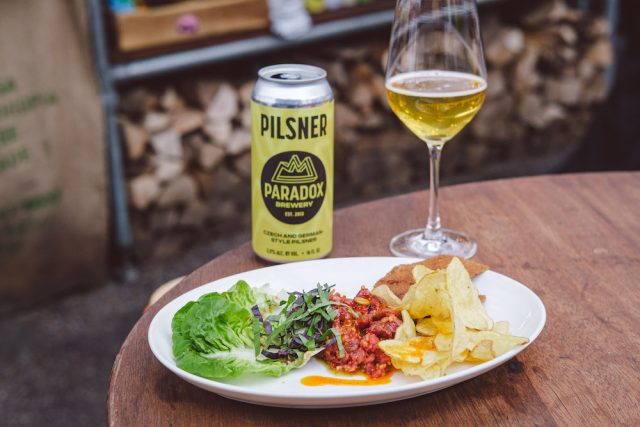
For the first course, Paradox Pils, with old-world pilsner malts and noble hops, create a “golden, crisp and crushable pilsner”, that was paired with beef tartare and sourdough gochuchang, new potato chip and cured egg yolk.
Using leftover sourdough bread to ferment into a gochuchang paste, similar to a miso, with huge umami flavours and subtle spice, the beer was a wonderful match. In a similar way to the Kolsch, the pilsner offered a mouth-cleansing clarity, and, as Paradox Brewery’s Devon Hamilton said, it matched with the “richness from the beef tartare, cleaning the mouth out nicely”.
Fish
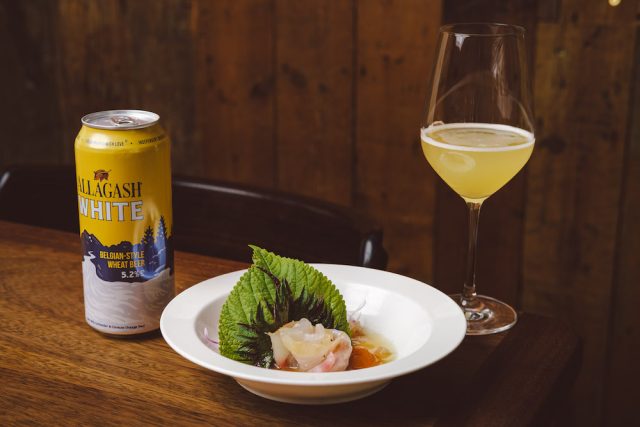
In the fish course, Allagash White was matched; a Belgian style witbier brewed with oats, malted wheat and unmalted raw wheat, spiced with coriander and Curacao orange peel. Allagash Brewing Co’s Kevin Stoneroad explained that the brewery was one of the first in the region to have a coolship; the traditional Belgium method of spontaneous fermentation, where hot, unfermented wort is cooled overnight using outside air temperature in a traditional, large shallow pan, dubbed the ‘coolship’.
Partner Content
During the cooling process, naturally occurring microbiota from the air inoculates the beer, and in the morning, it is transferred into French oak wine barrels where the entire fermentation and aging (over 1-3 years) takes place.
The beer matched with Konbu cured fish with fresh and aged daikon radish with brodo and apricot kosho. The dish showcased the bold vegetal and herb flavours with the brine of sea water. Brodo is a stronger flavour than stock but has clean notes, an “enriched stock”, while Kosho is a fermented sauce made from chilis and, in this case, apricot instead of the traditional yuzu.
The flavour was more stone fruit noted than citrus, which is the key focus of the pairing.
Pigeon
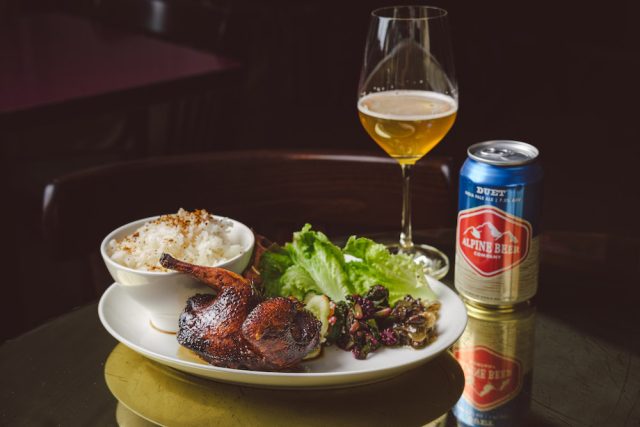
For the larger, game-led dish of pigeon, an Alpine Duet, which is a West coast style single IPA brewed with Simcoe and Amarillo hops, was matched with Squab – a young pigeon – and rice and pickles, home-made Worcestershire sauce and Koda farms rice.
Koda farms rice is from a small, family run farm in California that arguably could be one of the best rice producers in the world. It takes six years for each harvest from seed to dried. The squab was dry rubbed, deep fried, then rubbed again, stuffed with herbs and finished in Brat’s wood fired oven.
Served over the rice with pickles, it cleansed the palate along with the beer. Alpine Beer owner Tilray Brands’ Josh Daniels said that the beer “blends well” with the dish, with the cleansing citrus and floral notes against the richness of the pigeon and fermented pickles.
Dessert
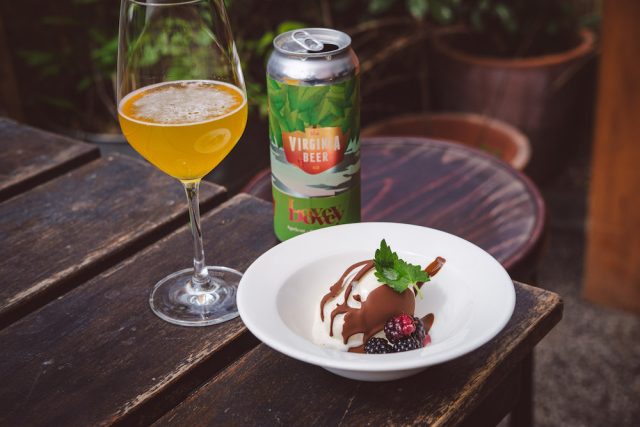
Dessert was a truly fermented match of food and beer, consisted of an Amazake Ice cream with faux-chocolate and fruit, with the WinWin chocolate made from spent brewer’s yeast.
Amazake is a Japanese beverage made from rice and koji, essentially using the same process as that used for making miso or mirin. Koji produces enzymes that break the starch down into sugars and carbohydrates. If left for a few days lactic acid bacteria will start to turn it sour, then eventually break the sugars into alcohol and if left even longer, you get eventually get sake.
Win Win chocolate is the first sustainable non-cocoa chocolate. Using barley, oat and carob, it is made by fermenting the grains and legumes, then roasting and grinding them like a cocoa bean. The product can be used 1:1 for chocolate in recipes. In this case, the chocolate has been blended with spent brewer’s yeast.
It was matched with Virgina Beer Co’s Lovey Dove, which is a stone fruit sour beer featuring peach, apricot and mango flavours.
Complementing
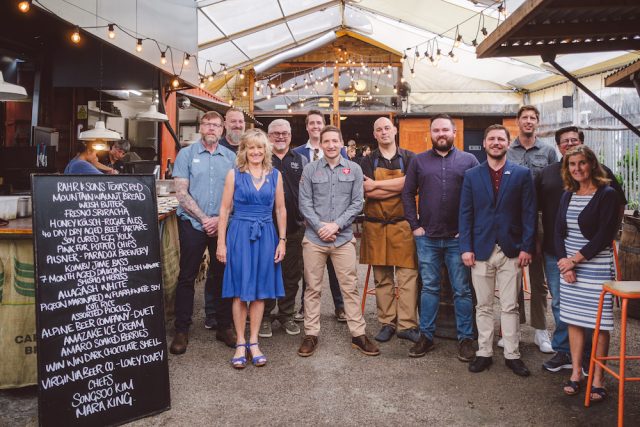
In conclusion, the event highlighted the significant potential to match fermented foods with a number of different beer styles, and how they can complement each other in interesting, and unexpected ways.
Adam Dulye, Brewers Association Executive Chef, said “Built from fermentation techniques and ingredients from across all restaurants, the menu brings fermented flavours together to demonstrate how they can complement and elevate the flavours of American craft beer.
It explored the flavour highlights of fermentation from spice to salt, sweet to tangy and to fermentation’s ultimate by-product, alcohol. The flavours of each dish are designed with the respective American craft beer in mind, building to a peak with the squab and finishing gently with a lightly sour beer and ice cream.”
Lotte Peplow, Brewers Association’s American Craft Beer Ambassador for Europe, added: “Fermentation is a natural process through which micro-organisms (like yeast) convert carbohydrates into alcohol or acids. This is how beer is brewed and food develops a distinctive tartness.
“It therefore stands to reason that beer and fermented foods should marry well together with beer adding hop bitterness and flavour to the zingy acidity of fermented foods.”
“The Brewers Association effectively showcases this concept with a unique, innovative approach to pairing American craft beer with fermented foods. The pairings are designed to broaden the diner’s perspective on the endless potential for combining beer with food and demonstrate to the industry why beer deserves a prominent place on the dinner table.”
All images supplied by Brewers Association/Nic Crilly Hargrave
Related news
Brewers Association CEO Bob Pease to retire
Brewers Association of India created
German Brewers' Association warns of 'extremely tense' beer bottle shortage




